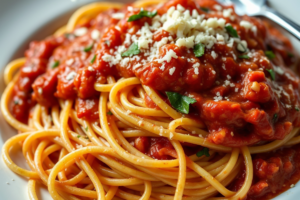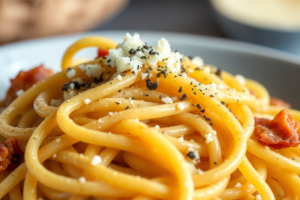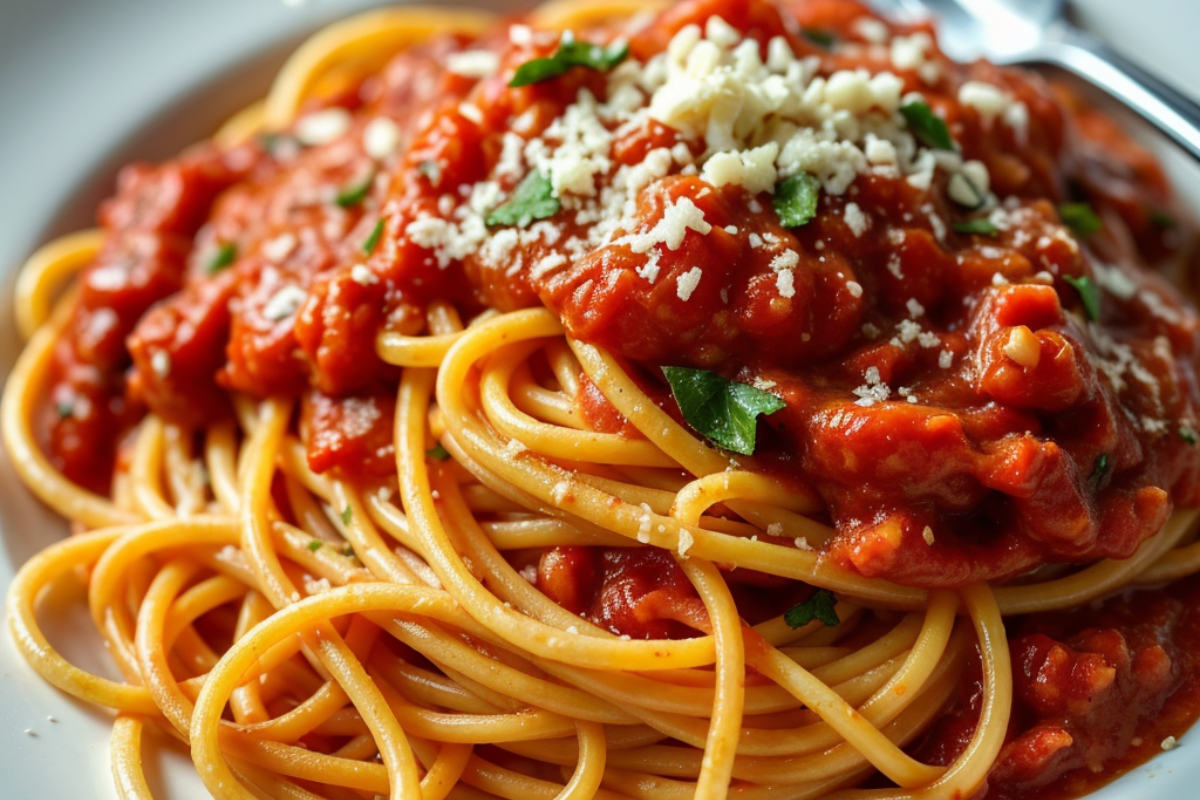Spaghetti is one of the most iconic dishes in Italian cuisine. It’s known worldwide for its long, thin strands and versatility. But what exactly is Italy spaghetti, and why is it such a staple in Italian culinary tradition? In this comprehensive article, we will explore the origins, ingredients, preparation methods, regional variations, modern adaptations, and cultural significance of this beloved pasta.

Introduction to Italian Spaghetti
In Italian cooking, spaghetti refers to a long, thin, cylindrical pasta made from durum wheat semolina. It is a key ingredient in many traditional Italian dishes. Spaghetti is celebrated for its ability to pair with a variety of sauces, making it highly versatile. It embodies the simplicity and richness of Italian cooking, where quality ingredients and straightforward methods create dishes loved by many.
Spaghetti has its roots in ancient Italy, where early pasta forms began to develop. The dish became popular across Italy due to its easy preparation and the availability of its basic ingredients. This simplicity made spaghetti a staple in Italian homes and restaurants. To better understand its role in Italian cuisine, you can explore this overview of Italian pasta dishes.
Moreover, Italian immigrants were key in spreading the love for spaghetti around the world, especially in the United States. They brought their recipes and traditions with them, making spaghetti a household name. Today, spaghetti continues to evolve but still holds onto its classic appeal. For more about the history of pasta, including spaghetti, consider reading In Rome Cooking’s article on the origins of pasta.
Historical Background of Spaghetti in Italy
The history of spaghetti in Italy goes back several centuries. The name “spaghetti” comes from the Italian word spago, meaning “string” or “twine,” which describes its shape. Pasta, including spaghetti, has been a part of Italian culinary history since the 12th century. However, spaghetti became widely popular in the 19th century. During this period, Naples became a hub for pasta production. Spaghetti was favored for its durability and long shelf life.
Evolution of Spaghetti in Italian Cuisine
Initially, pasta makers crafted spaghetti by hand. They mixed durum wheat semolina with water to form dough, then rolled and cut it into thin strands. This handmade process ensured a better texture and flavor. Many Italians still value handmade pasta today, even with the rise of industrial pasta production. Handmade spaghetti offers a coarser texture, which allows sauces to stick better to the pasta, enhancing the overall taste.
Furthermore, spaghetti’s popularity grew because it was affordable and had a long shelf life. This made it accessible to people from all walks of life. The Industrial Revolution brought new methods for making pasta, allowing spaghetti to be produced on a larger scale and shipped worldwide. Italian immigrants, especially in the United States, played a significant role in spreading the love for spaghetti. They brought their recipes and traditions with them.
Traditional Ingredients and Preparation Methods
To make authentic Italian spaghetti, chefs use high-quality durum wheat semolina. This type of wheat gives the pasta a firm texture, which helps the pasta keep its shape and absorb sauces well when cooked. The dough is mixed with water and kneaded until it reaches the right consistency. Then, it’s rolled out and cut into long strands.
The traditional way to cook spaghetti is to prepare it al dente, an Italian term that means “to the tooth.” This style of cooking ensures the pasta is firm to the bite, not too soft or mushy. Cooking spaghetti al dente requires careful timing and a pot of salted boiling water. To learn this technique, you can read this guide to cooking pasta the Italian way.
Types of Spaghetti in Italian Cuisine
Italian cuisine offers several types of spaghetti dishes, each with its unique ingredients and flavors:
- Spaghetti alla Carbonara: A Roman dish made with eggs, Pecorino Romano cheese, pancetta, and black pepper. It’s known for its creamy texture, achieved without using cream.

- Spaghetti Bolognese: Often seen as a tomato-based meat sauce outside Italy, but in Italy, it’s traditionally served as Ragù alla Bolognese with tagliatelle, not spaghetti.
- Spaghetti alla Puttanesca: A Southern Italian dish with a robust sauce made from tomatoes, olives, capers, and anchovies.
- Spaghetti Aglio e Olio: A simple but flavorful dish from Naples. It combines spaghetti with olive oil, garlic, and red pepper flakes.
Modern Adaptations of Spaghetti in Italy
Modern Italian chefs have added new flavors and methods to traditional spaghetti dishes. Today’s versions of spaghetti often include ingredients not traditionally used, like seafood or exotic spices. Some even have influences from other cuisines, such as Mediterranean or Asian.
Additionally, dietary needs have led to new types of spaghetti. Gluten-free and whole wheat spaghetti are now available. These options are great for those who want a healthier choice or have dietary restrictions. They offer the classic taste of spaghetti with added health benefits.
Popular Spaghetti Dishes in Italy
Italy has many famous spaghetti dishes that showcase its versatility. Here are some of the most popular:
- Spaghetti Carbonara
- Overview: A classic Roman dish that mixes eggs, Pecorino Romano cheese, pancetta, and black pepper.
- Preparation: Hot pasta is mixed with raw eggs and cheese to make a creamy sauce. Pancetta adds a salty flavor.
- Spaghetti alla Bolognese
- Overview: Made with a meat-based sauce that includes beef, pork, tomatoes, onions, and carrots.
- Difference from American Versions: In Italy, Bolognese sauce has less tomato and more meat. It’s usually served with tagliatelle.
- Spaghetti alla Puttanesca
- Overview: Known for its bold flavors, this dish uses tomatoes, olives, capers, anchovies, garlic, and red pepper flakes.
- Popularity: Especially loved in Southern Italy for its strong, tangy taste.
Spaghetti Sauces and Pairings
There are many sauces that go well with Italian spaghetti. Some of the most popular include:
- Marinara: A simple sauce made with tomatoes, garlic, onions, and herbs.
- Alfredo: More common in American-Italian cooking, made with butter, heavy cream, and Parmesan cheese.
- Pesto: A fresh green sauce from Genoa, made with basil, pine nuts, Parmesan cheese, and olive oil.
Furthermore, spaghetti is often served with a light salad or garlic bread in Italy. Wine pairings also enhance the dish. A crisp Pinot Grigio or a full-bodied Chianti are often recommended to bring out the flavors. For a broader look at different sauce options, visit this overview of pasta sauces.
Regional Variations of Spaghetti Dishes in Italy
Italy’s diverse culinary landscape offers regional variations of spaghetti. These reflect local ingredients and traditions:
- Spaghetti alle Vongole (Spaghetti with Clams): A favorite in coastal regions like Naples and the Amalfi Coast. This dish combines fresh clams with olive oil, garlic, white wine, and parsley.
- Spaghetti alla Nerano: From the village of Nerano on the Amalfi Coast. It features spaghetti with fried zucchini, Provolone del Monaco cheese, and basil.
- Spaghetti al Limone (Lemon Spaghetti): A light dish from the Sorrento peninsula. It combines spaghetti with a simple sauce of lemon zest, lemon juice, olive oil, and Parmigiano-Reggiano cheese.
Spaghetti in Different Italian Regions
Different parts of Italy have their own take on spaghetti dishes. In Northern Italy, spaghetti dishes might include richer ingredients like cream, butter, and cheese. Meanwhile, in Southern Italy, fresh ingredients like tomatoes, olives, and seafood are more common. This regional diversity allows for a wide range of spaghetti dishes, each catering to different tastes.
Cultural Significance of Spaghetti in Italy
Spaghetti is more than just food in Italy. It’s a symbol of Italian culture and heritage. It represents the simplicity and richness of Italian cuisine, where a few high-quality ingredients come together to make a dish that is both tasty and filling. In many Italian families, making and eating spaghetti is a group activity. It’s also a popular choice for celebrations and gatherings, loved for its ability to please many people.
Spaghetti in Italian Family Gatherings and Celebrations
In Italy, food plays a big role in social life and family gatherings. Spaghetti often takes center stage at these events because it’s easy to make and serves many. Making and serving spaghetti can be a shared experience, where family members gather to cook, share stories, and enjoy a meal. This group activity makes the dish more than just food. It becomes a symbol of unity and togetherness.
Modern-Day Popularity of Spaghetti
Today, spaghetti is one of the most popular types of pasta around the world. It’s loved for its ability to adapt to many different flavors and recipes. From classic Italian dishes to new fusion recipes, spaghetti inspires chefs and home cooks alike. It’s also a common item in packaged foods and on restaurant menus, solidifying its status as a timeless staple in the food world.
Spaghetti in Contemporary Italian Cuisine
Contemporary Italian chefs continue to reinvent traditional spaghetti dishes. They bring new life to this classic pasta by using non-traditional ingredients like seafood, exotic spices, and elements from other cuisines, like Asian or Mediterranean. This blend of flavors creates unique dishes that honor tradition while embracing new ideas. The evolution of spaghetti reflects Italy’s changing culinary scene, which balances respect for tradition with a desire to innovate.
Health Benefits and Nutritional Aspects of Spaghetti
Spaghetti is not just delicious; it can also be a healthy part of your diet when made with the right ingredients:
- Source of Carbohydrates: Spaghetti provides a lot of carbohydrates, which are important for energy.
- Rich in Fiber: Whole wheat spaghetti has more fiber, which is good for digestion and helps keep blood sugar stable.
- Low in Fat: If made with simple ingredients like tomatoes, garlic, and olive oil, spaghetti can be a low-fat meal.
- Rich in Protein and Nutrients: Adding lean meats, seafood, or plant-based proteins like beans can increase the protein content, making the dish more balanced.
Tips for Making Spaghetti Healthier
Here are some tips to make your spaghetti dishes healthier:
- Choose Whole Wheat or Gluten-Free Pasta: These choices have more fiber and nutrients than regular pasta.
- Add Fresh Vegetables: Including vegetables like tomatoes, spinach, and bell peppers can make the dish tastier and more nutritious.
- Limit Creamy Sauces: Use tomato-based or olive oil-based sauces to cut down on fat.
- Control Portion Sizes: Eating reasonable portions helps you keep a balanced diet and avoid overeating.
Innovations in Spaghetti Preparation
Modern technology and food trends have also changed how people make spaghetti. Some restaurants use machines to make fresh pasta every day, ensuring the best quality and taste. New cooking methods, like sous-vide, are also being used to improve the flavor and texture of spaghetti dishes. These innovations show how spaghetti keeps evolving while staying true to its roots.
Frequently Asked Questions (FAQs)
- What makes spaghetti different from other pasta?
Spaghetti is a long, thin pasta that pairs well with various sauces due to its shape and texture. - How is Italian spaghetti different from American spaghetti?
Italian spaghetti focuses on quality ingredients and simple cooking methods, while American versions often have more sauce and extras like meatballs. - What are the best sauces for spaghetti?
Popular sauces include Marinara, Carbonara, Puttanesca, and Pesto, which enhance the flavor and texture of the spaghetti. - Is there a specific way to cook spaghetti according to Italians?
Italians cook spaghetti al dente, meaning the pasta should be firm when bitten, not soft or mushy. - Can you make spaghetti gluten-free?
Yes, many gluten-free spaghetti options are available, made from alternative grains like rice, corn, or quinoa.
Conclusion and Final Thoughts
Spaghetti remains a key part of Italian cuisine. It’s loved for its versatility, simplicity, and ability to fit with many flavors and ingredients. Whether you enjoy traditional dishes like Spaghetti Carbonara or explore new versions with gluten-free options, spaghetti offers a taste experience that appeals to everyone. Knowing its origins, different types, and cultural significance can help you appreciate this classic Italian pasta even more. So, the next time you make a spaghetti dish, remember the rich history and tradition behind each strand.
By combining its traditional roots with modern ideas, spaghetti continues to show why it’s a favorite in Italian cuisine. Its ability to adapt while keeping its original character makes it popular not just in Italy but worldwide. As food trends change, so will spaghetti, proving that this simple pasta can stand the test of time and keep bringing joy to those who love its delightful taste.

